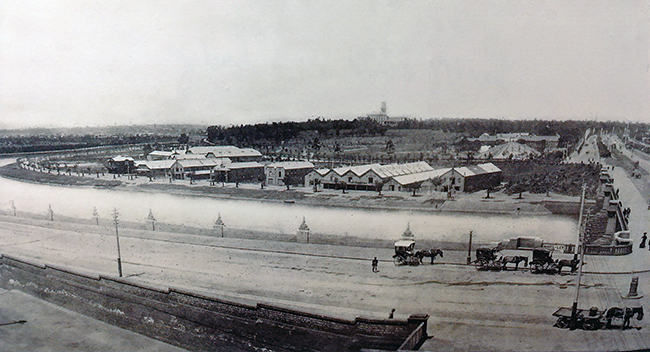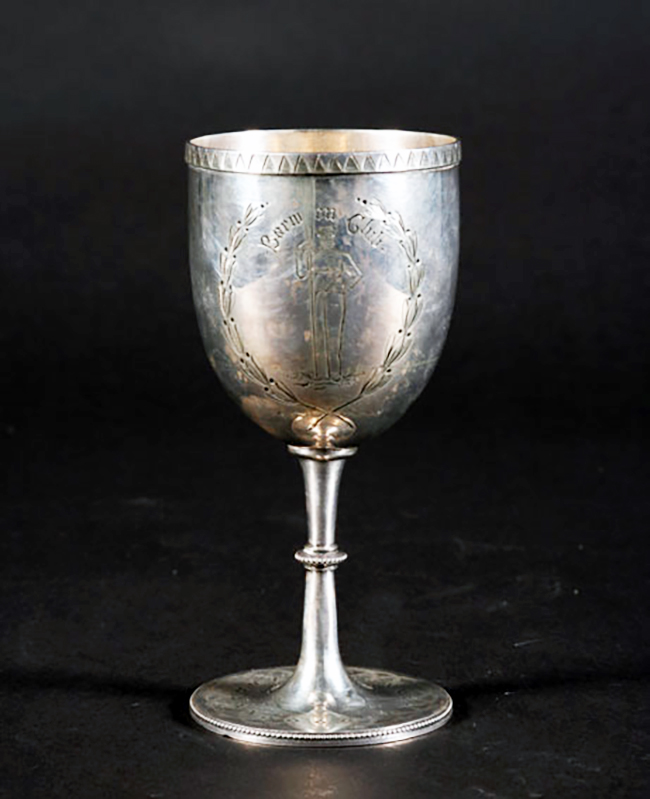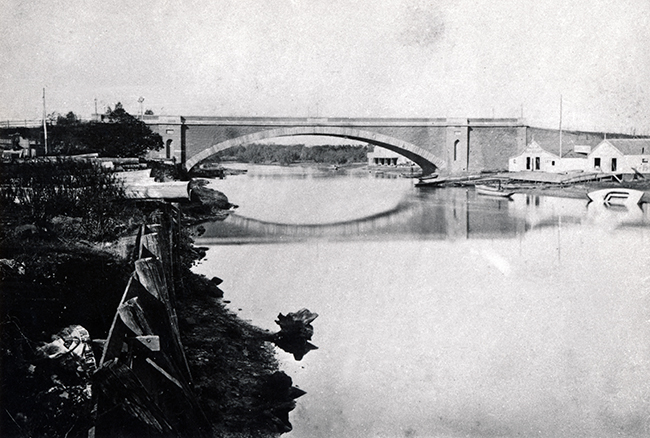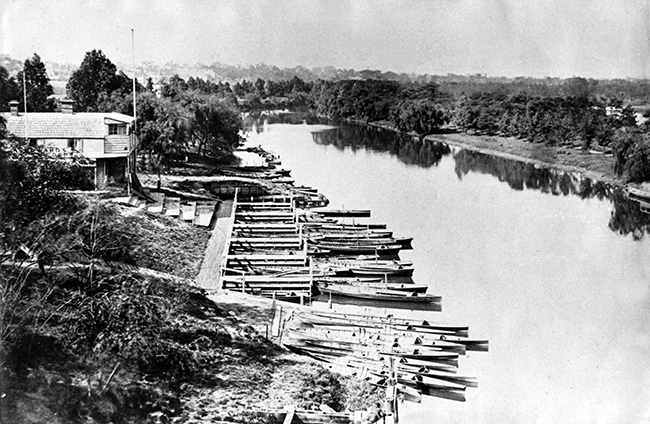Chapter 3 page 1 2 3 4
The broader picture

The boatshed area in Melbourne pre the new Princes Bridge completed in 1888, showing the old bridge

The Princes Bridge boatshed area after completion of construction of Princes Bridge in 1888
Regatta seasons
1876-77
The Committee for the initial year was:
Honorary Secretary - Mr Frank Shew (University) initially but after his resignation half way through the year, Mr Thomas H Young (Melbourne Rowing Club)
Honorary Treasurer - Mr Arthur Nichols (Ariel - also spelt Nicholls at times and thought to be the sculler competing in the late 1860s rather than the A Nichols from Melbourne RC who was a sweep rower in 1870s. As Mr Nichols chaired the the first two annual meetings, it may be adduced that a more mature person would be given that roll. However, there is no great confidence in this conclusion.)
Committee (comprising ten elected members and one representative from subscribing £10 annually to the Association.): Messrs. Rolls, Willan, Watson, Cope, Irvine, Reid, Barker (resigned during season), Hood,
McIntosh, H. A. Williams (resigned during season), Hodges (elected during season), Coates, Carter and Ward.1
The initial Clubs were Albert, Albert Park, Ballarat, Ballarat City, Banks, Barwon, Boroondara, Civil Service, Corio, Footscray, I. Zingari, Melbourne, Murray, Richmond, University, Warehousemen, Williamstown and Yarra Yarra.2
The Committee in the first annual report lamented that "only five of them, viz. Banks, Civil Service, Footscray, Melbourne and University, responded to the invitation and guaranteed the money. It is hardly fair that the burden of providing funds should be borne by so few clubs. It is therefore desirable, for this and other reasons, that more clubs should send representatives to the committee, who are able and willing to perform the required duties, and bring the necessary grist to the mill."
The first year of the Association was thorough as the new officials found their bearings and new authority to run the sport. The sports participants were doing the same. Obviously there were those highly enthusiastic for the new organisation and those who were skeptical of the need for it or the extent of its powers. Regardless, the new Association did what it established to do -
- run regattas (specifically the Melbourne Regatta and Intercolonial competitions)
- select, coach and manage Victorian crews, and
- act as a Parliament of clubs to set the course of rowing in the colony, establish the rules of racing and adjudicate on any issues.
As an aside, the activities of the Association have changed little in the first 150 years of operation. The only slight difference is that in more recent years, the Association has taken on more development activities as part of the national Pathways program.
The Committee was quick off the mark immediately taking over the assets and responsibilities of the de facto former Association, namely the Melbourne Regatta Committee.
The season opened on 25th November 1876 with a scratch eights race with eleven entries. The winning crew comprised Messrs. Taylor, Sneddin, W. Clegg, Hyslop, Lang, Carlile, Forrester, A. Nichols (stroke).
The next big event to be organised by the Association was the Melbourne Regatta, the de facto Championship regatta. The first annual report provided the following details:
"The first Melbourne Regatta under the auspices of this association was held at the Saltwater River on the 24th March last. Although the weather was as usual, very disagreeable, the attendance of the public was satisfactory, and allowed that an increased and more general interest is being taken in aquatic sports. The entrance fees, the largest yet received, amounted to £114, no less than 128 men entering for the various events on the programme. The racing, however, was not very exciting. The principal prize of the regatta, the Footscray Challenge Cup, for Senior Eights, resulted in a walkover. The winning clubs were: - Melbourne Challenge Eight, Ballarat Maiden Sculls, Zingari Challenge Sculls, Warehousemen Maiden Pair, Banks Junior Scull, Murray Maiden Four, Barwon The Leader Challenge Cup. The proprietor of the Australasian, as usual, gave the winner of the Challenge Sculls a handsome trophy, for which your committee express their thanks."

Barwon Rowing Club individual trophy for winning the Leader Challenge Cup for Junior Eights
The regatta was not without controversy with protests being received and the Association forced to make decisions. Cazaly and Stout each accused each other of fouling the other in the sculling race. These were dismissed as out of time. Further, Williamstown protested against Footscray that the crew raced with a senior oarsman. This protest was also dismissed on the basis that there was no record of this oarsman racing senior in an advertised race. It was a good thing that the presentation of trophies took place a month after the regatta to allow such matters to be resolved.1
At this time, the falls still existed above Queens Street and created a barrier for getting boats onto the Lower Yarra course. The committee of the new Association took it upon themselves to lessen the likelihood of boat damage through representations being made to the relevant Minister of the requirements. The annual report stated that: "A capital platform has been built and other suitable work performed, thus adding to the safety of the property of the various clubs, and the convenience of rowing men generally."
The last of the Association's responsibilities was to arrange Intercolonial competitions and select Victorian crews. The first annual report states their progress in this regard.
"With this object in view your committee communicated with the Sydney oarsmen. Your committee are now in a position to state that the challenge issued by them for a race in eight-oared boats between this colony and New South Wales has been accepted. The first Saturday in March next has been fixed on our side as a suitable time for the match to come off. Messrs. Coates, Hood and Rolls have been appointed to select a crew. Your committee have no doubt that with the rowing talent on the river the colony will be ably represented, and that the crew on the day will give a good account of itself."
The finances of the Association grew from the inheritance the Melbourne Regatta Committee of £17 14s.4d to a final balance of £55 8s.5d., after payment of all expenses, particularly the prizes.
In summary after the first year, the Association's committee concluded to member clubs that it has "every reason to congratulate you upon the present position and prospects of aquatics in this colony." Certainly the Association undertook its responsibilities well and to the benefit of the sport.

Looking east downstream of the old Princes Bridge

Looking east from the old Princes Bridge showing James Edwards' home and northern bank boatshed
1877-78
The next season saw more interest in rowing both on and off the water.
Footnotes
- First annual report of the Association as reproduced in The Age: VICTORIAN ROWING ASSOCIATION. (1877, October 1). The Age (Melbourne, Vic. : 1854 - 1954), p. 3. Retrieved December 25, 2023, from http://nla.gov.au/nla.news-article206920847
- The Victorian Oarsman by John Lang published by A H Massina & Co 1919, page 47
< previous Chapter 2
> next Chapter 4
top of page






